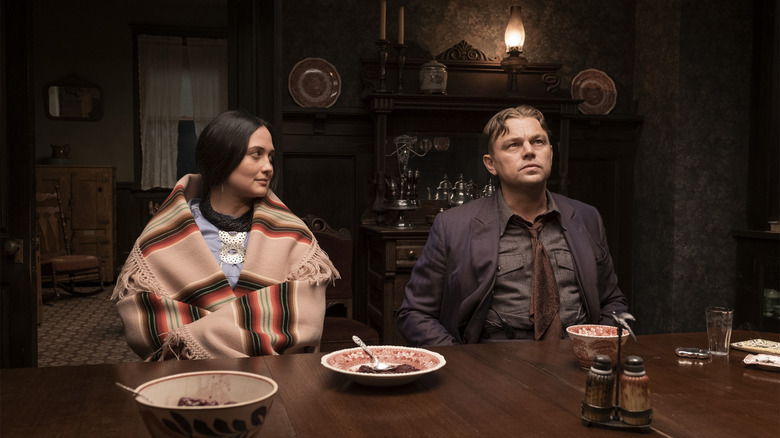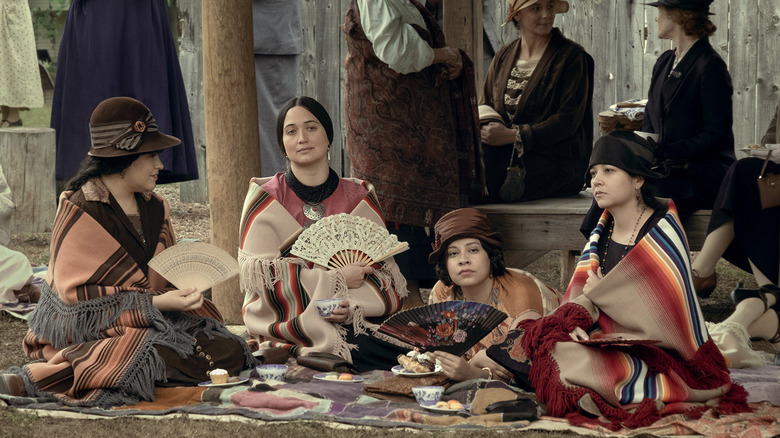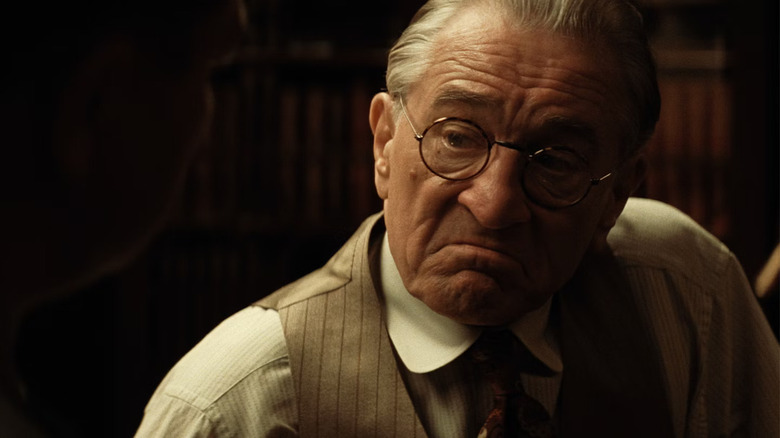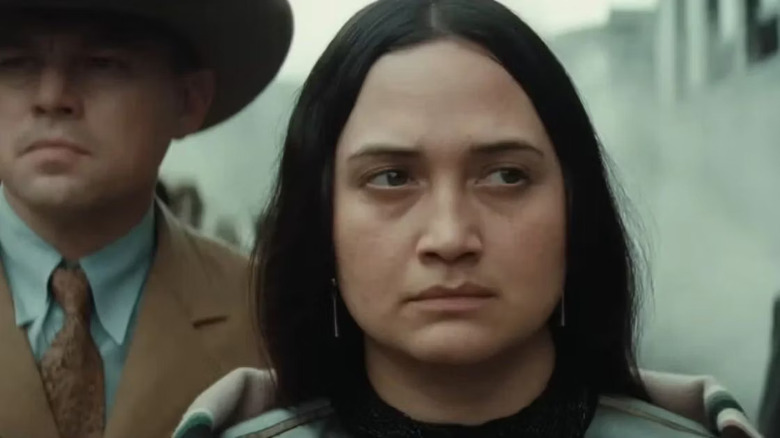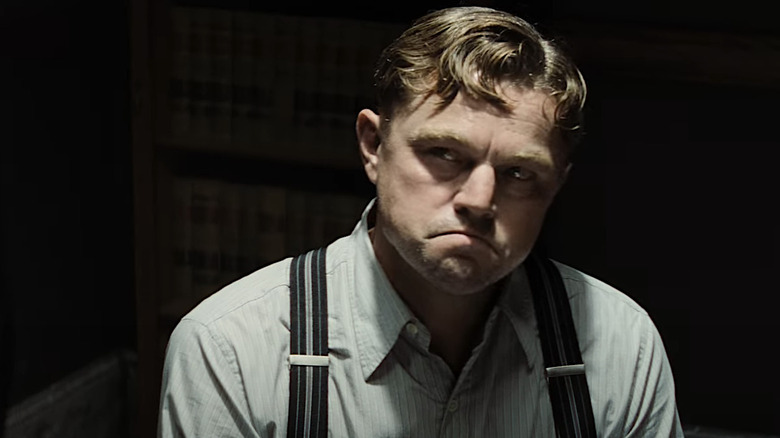Killers Of The Flower Moon Ending Explained: A False King's Reign Of Terror
This post contains major spoilers for "Killers of the Flower Moon."
Based on the nonfiction book "Killers of the Flower Moon: The Osage Murders and the Birth of the FBI" by American journalist David Grann, Martin Scorsese's film adaptation is being hailed as one of the best films of 2023. The film is, in typical Scorsese fashion, a film analyzing white masculinity and the way men will ruin the lives of others in order to appease one another and their own selfish desires. It is also, again in Scorsese fashion, tackles themes of guilt, status-seeking, and people pushed outside the margins by society. In this case, the people of the Osage Nation who were terrorized and murdered en masse in a conspiracy plot by white people looking to steal their wealth, a historical event that many people don't know ever happened.
Scorsese brings together two muses from two different eras of his career — Robert De Niro and Leonardo DiCaprio — to star as William Hale and Ernest Burkhart, the titular "killers." Joining the duo is Lily Gladstone, who delivers a breathtaking turn as Mollie Kyle, the Osage woman Burkhart married, whose family was annihilated in these white men's quest for power. Films that are "based on a true story" are nothing new, but with creative liberties often taken by filmmakers, viewers might be wondering how close the film was to the actual events.
Here's the ending of "Killers of the Flower Moon" explained.
Oil that is, black gold
After having been relocated to a plot of land now known as Oklahoma, the indigenous people of the Osage Nation discover massive plots of oil. The Osage retained mineral rights to the land and sovereignty of what would later become the Osage reservations, which meant that they — not the United States — had ownership over the oil discovered. This turned the Osage Nation into the richest people per capita on the planet. Of course, this wealth was immediately coveted by entitled white people who felt they were more deserving of it, believing the Natives were incapable of handling the wealth themselves.
So Congress passed a law in 1921 requiring guardians for every Osage of "half-blood or more" in ancestry. Meaning, the Osage were legally required to have a white person to handle their money for them until they could prove "competency." These guardians were often white lawyers or businessmen, and as history would prove, these men used guardianship or marriages to legally steal Osage land, headrights, and royalties.
Scorsese's film introduces us to Ernest Burkhart, who moves to Osage County to be near his brother Bryan and uncle William Hale. Hale considers himself the "King of Osage Hills," a well-trusted, loved, and wealthy white man in the community who owned a large ranch. Many of the Osage have died under mysterious circumstances without any investigation, but things kick up after Ernest meets an Osage woman named Mollie Kyle. Burkhart seems sincerely smitten with her, and Hale pushes for the two to marry for his own selfish interests. If Burkhart marries Mollie, and her entire family dies, Ernest would inherit an entire bloodline's wealth.
And if Burkhart were to die, his next of kin would get the money ... next of kin being William Hale.
As American as white greed and racism
The lengths that William Hale goes through to manipulate and solicit murder while attempting to set up his conspirators to take the fall is some John "Jigsaw" Kramer in the "Saw" series behavior. But it's made even more deplorable with the knowledge that Hale was a real person who caused the deaths of real people. In any other film, "Killers of the Flower Moon" would have set up the mysterious deaths of the Osage like a murder mystery, but Scorsese is smarter than that. History knows who did it, so Scorsese never shies away from naming the real culprits or exposing their greedy, racist, cruel motivations. He doesn't want the audience to see things from the murderer's perspective, as a means of humanizing them, but to expose them and the systems in place that allowed them to thrive.
America's original sin is the unchecked mistreatment of Indigenous people that serves as the foot of the country's "founding," and the violence depicted in "Killers of the Flower Moon" is the genocidal tree bearing fruit. It's through the perspective of the Osage people, which Scorsese worked tirelessly to include, that the audience is meant to see William Hale, Ernest Burkhart, and their co-conspirators. Additionally, the traditions, practices, and culture of the Osage are presented with authenticity — a stark contrast to, as one character describes them, the "savage" behavior typically at the center of Hollywood depictions. The victims of Hale and his gang of murderers aren't treated like nameless fodder for a body count, they were vital members of a vibrant community whose lives were stolen like plots of land.
Between 1921 and 1925, at least 60 Osage people were murdered or disappeared. While "Killers of the Flower Moon" depicts the murders of Henry Roan, Anna Brown, Reta (and her white husband, Bill Smith), and Lizzie Q, they are just a fraction of the lives lost in William Hale's Reign of Terror.
Judge, jury, and expert manipulator
King Hale and his conspirators managed to get away with their crimes for as long as they did because the land of Osage County wasn't overseen by the federal government. It wasn't until the investigative department of the newly-formed Bureau of Investigation (which would become the FBI) showed up that Hale was finally able to be held accountable. As "Killers of the Flower Moon" depicts, Hale believed he would still be untouchable, as he had gained such a great standing in the community. He and his lawyer W.S. Hamilton (Brendan Fraser) tried to manipulate Ernest, who is implied to be of a lesser-intelligence, from testifying against him. Fortunately, Ernest does eventually come clean and testifies against him, as do the rest of the co-conspirators.
However, while the legal ramifications and judicial accountability are important, it's the judgement of Mollie that Scorsese rightfully gives the heaviest weight. Her family was wiped out as a result of the actions of these white men, so as far as the film is concerned, her perspective is the most important. She does not forgive. She does not excuse. She does not allow her relationship with Burkhart to define the rest of her life — but she certainly does not forget. The true tragedy, as the final scene points out, is how quickly history elected not to prioritize the preservation of the Osage Nation's story. This is a moment that history books seldom include, with some states even today trying to legislate even discussing it.
"Killers of the Flower Moon," admittedly, should have been told exclusively from the perspective of the Osage people. But the Osage are well aware of their history and the atrocities their people endured. It's fortunate that Scorsese's film at least forces the predominantly white audiences watching the film to be seen through Mollie's eyes and answers the questions: "How complicit would you have been, and how complicit do you continue to be now?"
The factual aftermath
The film's epilogue is performed through a true crime radio performance, as actors and foley artists conclude the epic saga. The Shoun brothers were not persecuted as there was not enough evidence. William Hale was sentenced to life in prison, but later paroled and lived to be 87, and it's insinuated that he may have bribed his way out. Kelsie Morrison was charged with the murder of Anna Brown. Ernest Burkhart was sentenced to life in prison but later pardoned by Governor Henry Bellmon. Burkhart died in 1986, after living the rest of his days with his brother Bryan (also convicted as an accomplice) in a trailer park.
Mollie divorced Ernest following the trials, later remarrying John William Cobb Jr. She tragically passed away on June 16, 1937, but her children inherited all of her estate. As was narrated in the film's final moments, she was buried in the same cemetery as her family members who preceded her in death, and her obituary made no mention of her ex-husband or the murders. This is where Scorsese's film ends, but it is in no way the end of the story of the Osage people.
In 1925, Congress passed a law that prohibited non-Osage from inheriting headrights from those who had half or more Native ancestry, effectively closing the loophole exploited by Hale. The U.S. Department of Interior began to manage the trust lands and pay the Osage with headrights, but the Elouise Cobell (Blackfeet) filed a class-action suit against the Interior and Treasury in 1996, and the Osage tribe again filed a lawsuit against the department in 2000 alleging that "federal government management of the trust assets had resulted in historical losses to its trust funds and interest income." Eventually, the U.S. government settled with the Osage in 2011 for $380 million, the largest trust settlement with one tribe in American history.
